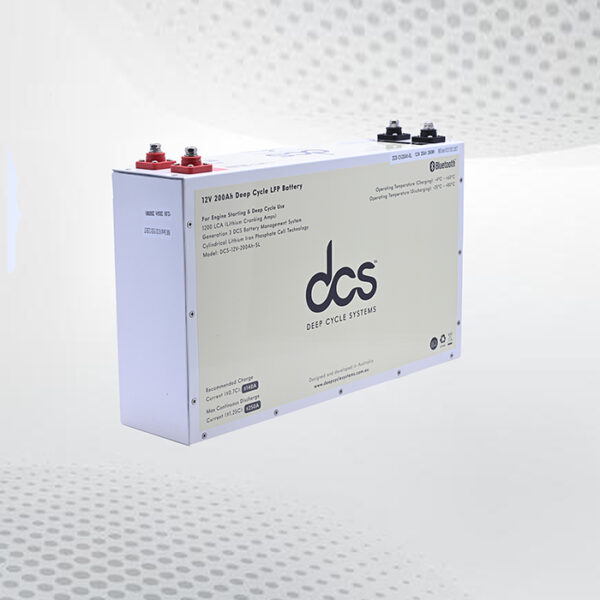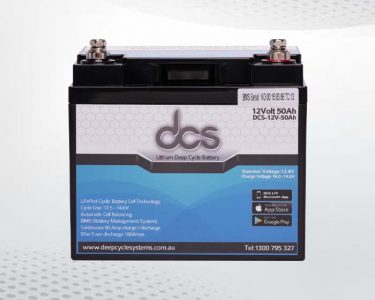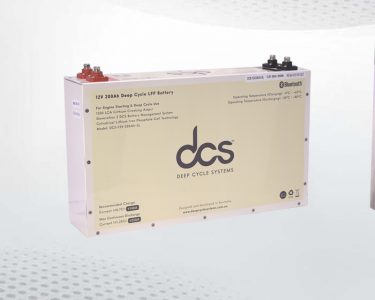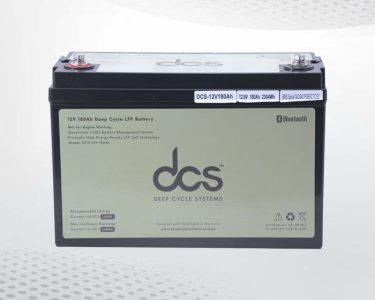As marine enthusiasts, we all know the importance of a reliable battery system. The 100-ah deep-cycle marine battery has become increasingly popular due to its high capacity and long-lasting performance. But what makes this battery different from others? This post will delve into the technology behind the 100ah Deep Cycle Marine Battery, its components, and how it provides a reliable power source for your aquatic adventures. So, let’s dive in and discover the inner workings of this essential piece of technology for any boat owner.
Understanding Deep-Cycle Batteries and Their Importance
Deep-cycle batteries are designed to provide a steady amount of power over a prolonged period, making them an essential component in marine applications where reliable energy is a must for both navigation and auxiliary systems.
Unlike starter batteries, which discharge a high burst of energy for a short duration to crank an engine, deep-cycle batteries can be discharged to a significant extent of their capacity and then recharged repeatedly without substantial degradation. This characteristic is particularly crucial in marine settings where the battery must power equipment over extended voyages without access to external charging sources.
The ability of a 100Ah deep-cycle marine battery to endure numerous deep discharge and recharge cycles without losing its efficiency is vital for sustaining essential onboard electronics, lights, and other equipment. This resilience not only ensures safety and convenience but also contributes to the sustainability of marine adventures by reducing the frequency of battery replacements. Understanding the unique attributes of deep-cycle batteries highlights their significance in marine contexts, where the demand for dependable and durable power sources is paramount.
The Anatomy of a 100ah Deep-Cycle Marine Battery
Delving into the structure of a 100Ah deep-cycle marine battery reveals a sophisticated arrangement designed to withstand the demands of marine environments. At its core, the battery is composed of thick lead plates submerged in an electrolyte solution, typically sulphuric acid. These plates are denser compared to those found in regular starter batteries, enabling the deep-cycle battery to deliver a consistent power output over longer periods.
Separators made of porous synthetic material are placed between each plate to prevent short circuits while allowing ionic transfer, which is crucial for the battery’s charging and discharging processes. The heavy-duty construction of the case encasing these components is specifically engineered to resist vibration and shocks, which are common in marine settings. Valves regulate the internal pressure, ensuring safety and prolonging the battery’s lifespan by releasing excess gas generated during charging.
Additionally, the terminals are designed to offer robust and corrosion-resistant connections to the boat’s power system. This intricate assembly encapsulates the resilience and efficiency of the 100Ah deep-cycle marine battery, making it a cornerstone of reliable marine power solutions.
Selecting the Right Battery for Your Vessel
When embarking on the journey to select the right 100Ah deep-cycle marine battery for your vessel, several crucial factors come into play. Making an informed decision is essential to ensure compatibility and maximise efficiency.
Evaluate Your Power Requirements
Begin by assessing the energy demands of your onboard equipment. Understanding cumulative power usage will guide you towards a battery with the appropriate capacity to meet your needs without overburdening the system.
Consider the Battery Type
Deep cycle batteries come in various types, including lead-acid, AGM (Absorbent Glass Mat), and lithium-ion. Each has unique advantages, with lithium-ion offering the best energy density but at a higher cost. Choose the type that aligns with your budget and performance expectations.
Check Compatibility
Ensure that your selected battery is compatible with your vessel’s charging system. Choosing a battery your onboard charger can charge efficiently is pivotal to avoid potential charging issues or inefficiencies. Size and Weight Constraints
Space is often at a premium on vessels. Consider the physical dimensions and weight of the battery to ensure it fits within your designated space without causing imbalance or overcrowding.
Environmental Considerations
Opt for a battery that can withstand the environmental challenges of marine settings, including moisture, temperature fluctuations, and potential vibration. Durability in such conditions is key to long-term reliability and performance.
Installation Tips and Best Practices
To ensure that your 100Ah deep-cycle marine battery delivers its full potential, it’s vital to adhere to several key installation guidelines. First and foremost, the battery should be positioned in a cool and dry location to prevent overheating and minimise exposure to moisture. Securing the battery firmly is crucial to mitigate the risk of movement or vibration that could lead to internal damage, especially in rough marine conditions.
The connections should be made carefully, using clean, corrosion-resistant terminals to establish a solid electrical link to your boat’s systems. Applying a thin layer of petroleum jelly on the terminals is advisable to further guard against corrosion.
For safety, ensure all electrical work is completed with the power off to prevent accidental short circuits. Following these steps meticulously will pave the way for a successful installation, allowing you to enjoy an uninterrupted power supply aboard your vessel.
Charging Your 12v 100 Amp Hour Deep Cycle Battery
Charging your 12v 100 Amp Hour Deep Cycle Battery efficiently maximises its lifespan and ensures consistent performance. Begin by selecting a charger that matches the battery’s specifications, ideally one with smart charging capabilities to adjust the charge rate according to the battery’s condition. Connect the charger to the battery terminals, observing the correct polarity to prevent damage.
Initiate the charging process in a well-ventilated area to allow any gases produced to dissipate safely. It’s important to charge the battery slowly, using a low amperage setting, to avoid overheating and potential damage to the internal components.
Regularly monitor the battery’s voltage and temperature throughout the charging process to ensure it remains within safe limits. Once fully charged, disconnect the charger and check the battery’s terminals for any signs of corrosion or wear, addressing these promptly to maintain optimal connectivity. Adhering to these guidelines will help preserve the battery’s health, enabling it to deliver reliable power when needed.
Routine Maintenance to Prolong Battery Life
Establishing a consistent maintenance routine is crucial to ensuring the longevity of your 100Ah deep-cycle marine battery. To prevent potential short circuits, keep the battery’s surface clean, wiping away any dust, dirt, or moisture that may accumulate. If your battery type permits, regularly verify the electrolyte levels, topping up with distilled water as necessary to maintain optimum levels.
Examine the terminals frequently for corrosion signs; a mixture of bicarbonate of soda and water can effectively neutralise and clean any corrosion detected. It’s essential to securely tighten all connections to maintain efficient electrical flow and prevent energy loss. Additionally, inspect the battery case for any cracks or leaks that could compromise the battery’s integrity. Adopting these practices will significantly preserve the battery’s health and ensure consistent performance over time.
Understanding and Monitoring Battery Health
Keeping a vigilant eye on your 100Ah deep-cycle marine battery’s condition is vital to effectively safeguard against the inconvenience of sudden battery failures during your marine escapades. Employing a battery monitor or voltmeter facilitates regular checks of the voltage levels, providing a clear insight into the battery’s operational health.
This proactive approach identifies potential issues early, such as sulphation, which can significantly impede performance. Initiating corrective measures promptly upon detecting any deviation from the norm ensures the battery remains conducive to delivering its expected performance. Vigilance in monitoring, coupled with immediate response to irregularities, forms the cornerstone of maintaining battery health, reinforcing the reliability of your marine vessel’s power supply.
Troubleshooting Common 100 Amp Battery Issues
Facing challenges with your 100 Amp Battery, such as diminished performance or inability to hold a charge, requires a systematic approach to identify and rectify the issue. Initially, inspect the battery terminals for corrosion or loose connections, which can impede the flow of electricity. Utilise a multimeter to ascertain the battery’s current voltage; a reading significantly lower than expected may indicate an underlying problem.
If the battery appears unable to maintain a charge despite these checks, it could be a sign of internal damage or failure. Testing the battery under load is prudent, as this can reveal capacity issues that are not apparent during a standard voltage check. Should these steps confirm a fault with the battery, consultation with a professional or considering a replacement may be the most appropriate to ensure your marine adventures remain uninterrupted.
Optimising Your Marine Battery’s Performance
To enhance the efficacy of your 100Ah deep-cycle marine battery, embracing additional measures beyond regular maintenance can prove beneficial. Employing a desulfator can significantly mitigate the effects of sulphation, a common cause of battery performance degradation. This device rejuvenates the battery by dissolving sulphate crystals on the lead plates, thereby improving its ability to hold a charge.
Furthermore, the charger is designed for deep-cycle batteries, which can extend battery life. These chargers adapt the charging rate to the battery’s needs, reducing the risk of overcharging and undercharging, which are detrimental to the battery’s longevity. Incorporating these practices into your battery care regimen can amplify your battery’s performance, ensuring that it remains a reliable source of power for your marine adventures.
Recycling and Proper Disposal of 100 Amp Hour Deep Cycle Marine Battery
As the lifecycle of your 100Ah deep-cycle marine battery reaches its culmination. It is imperative to approach its disposal with a sense of environmental responsibility. These batteries contain lead and sulphuric acid, posing significant ecological risks if incorrectly handled rather than relegating your old battery to a landfill, which can contribute to pollution. Seek out authorised recycling centres or marauthorised stores offering recycling services.
These facilities can safely dismantle the 100 Amp Hour Deep Cycle Marine Battery, ensuring harmful components are neutralised, and recyclable material. By choosing to recycle, you comply with environmental regulations and contribute to the circular economy. It support the creation of new batteries from reclaimed materials. Remember, proper disposal underscores a commitment to preserving our marine environments for future generations.
Maximising Efficiency of Your 100Ah Deep-Cycle Marine Battery
Adopting energy-conscious habits aboard your vessel is key to optimising the efficiency of your 100Ah deep-optimise cycle marine battery. Assess the energy demands of your equipment and prioritise the essential use when operating off-grid. Implementing LED lighting can significantly reduce energy consumption compared to traditional bulbs.
Additionally, integrating solar panels or a wind turbine can supplement your power supply, reducing your reliance on the battery and prolonging its charge. Managing power usage by scheduling high-demand activities during peak generation times can also help maintain battery efficiency.
Ensuring that your charging system is accurately calibrated to your battery’s needs will prevent energy wastage and improve the battery’s optimum performance. Through these strategic approaches, you can ensure that your marine adventures are both eco-friendly and efficient, allowing for prolonged sea enjoyment.
Benefits of Investing in a 12 Volt 100 Amp Deep Cycle Battery
Investing in a 12-volt, 100-amp-hour deep-cycle battery offers numerous advantages for marine enthusiasts. Such batteries are engineered to endure the rigorous demands of maritime environments, ensuring your vessel remains powered even under challenging conditions. Their deep discharge capability allows for extended use of electronics, navigation systems, and other essential equipment without the risk of power shortages.
The durability of these batteries is a significant asset, as they are designed to withstand numerous charge and discharge cycles, offering a longer service life than standard batteries. This resilience translates into fewer replacements and lower long-term costs.
Additionally, the adaptability of these batteries to various charging sources, including solar and wind energy, facilitates a more sustainable approach to power management on board. Opting for a 12 Volt 100 Amp Deep Cycle Battery enhances your marine vessel’s operational efficiency and contributes to a more reliable and enjoyable boating experience.
Extend the Life of Your 100Ah Deep-Cycle Marine Battery.
Extending the operational lifespan of your 100Ah deep-cycle marine battery requires adherence to a comprehensive maintenance and usage regime. Ensure regular cleaning to remove debris or moisture, which could lead to corrosion and energy inefficiency.
It’s imperative to avoid allowing the battery to undergo deep discharges, as this can cause irreparable damage to the internal components, reducing the battery’s overall capacity. Additionally, it safeguards against the risks of overcharging by utilizing a smart charger that can utilise the charging process according to the battery’s current state.
Keeping the battery within a controlled temperature range also mitigates degradation. Integrating these practices into your routine bolsters the battery’s durability and performance, ensuring your marine adventures are optimised reliably for an extended period.
Conclusion
Understanding and effectively managing a 100Ah deep cycle marine battery ensures a reliable and prolonged power supply for aquatic adventures. Through careful selection, regular maintenance, and strategic usage, boaters can significantly enhance their battery’s performance and longevity. Embracing the tips and best practices outlined can lead to more eco-friendly and efficient maritime experiences. Underlining the importance of this robust technology in the boating world. By investing in and caring for a high-quality marine battery, enthusiasts can enjoy uninterrupted sea exploration and be confident in their vessel’s power resilience.
FAQs
Q: How long does a 100Ah deep cycle marine battery last on a single charge?
A: The duration of a 100Ah battery depends significantly on the power demand of the devices it’s supplying. Under moderate use, it could last for 24 hours, but this varies based on the total wattage of connected appliances.
Q: Can I use a 100Ah deep-cycle battery to start my boat engine?
A: Whilst deep-cycle batteries are primarily designed for prolonged energy output, they can start engines. However, it’s advisable to use a dedicated starter battery to ensure peak performance and longevity of your deep-cycle battery.
Q: Is it necessary to fully discharge my 100Ah battery before recharging?
A: No, deep-cycle batteries benefit from not being fully discharged before recharging. Keeping the discharge level above 50% can help extend the battery’s lifespan.
Q: How often should I perform maintenance on my 100Ah deep-cycle marine battery?
A: To maintain optimal performance, regular maintenance, such as checking for corrosion, ensuring connections are tight, and verifying electrolyte levels (for non-sealed batteries), should be conducted monthly.
Q: Can I connect solar panels to my 100Ah deep-cycle battery for charging?
A: Yes, solar panels can charge your deep-cycle battery, making it an eco-friendly option for maintaining charge levels, especially during extended marine voyages.
| Related Business Listings |
| Directory Submissions |
| Regional Directory |







